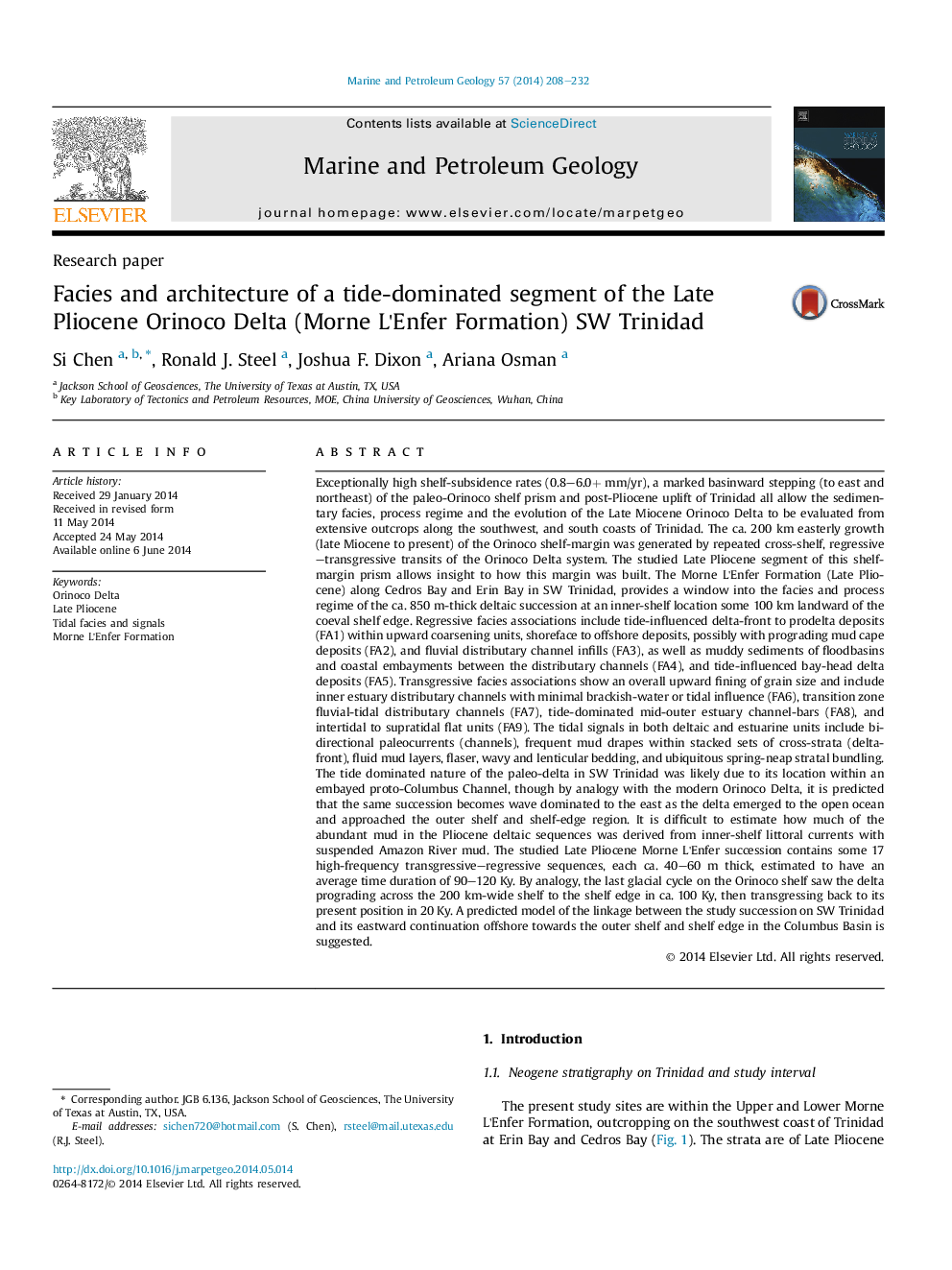| کد مقاله | کد نشریه | سال انتشار | مقاله انگلیسی | نسخه تمام متن |
|---|---|---|---|---|
| 6435344 | 1637167 | 2014 | 25 صفحه PDF | دانلود رایگان |

- Nine facies associations of the paleo-Orinoco Delta system have been recognized.
- A series of regressive-transgressive cycles have been documented.
- The correlation between Cedros Bay and Erin Bay has been tentatively built.
- A vertical change from distal deltaic up to delta-plain deposits has been shown.
- A predicted larger scale, continuation of the succession to the east is suggested.
Exceptionally high shelf-subsidence rates (0.8-6.0+Â mm/yr), a marked basinward stepping (to east and northeast) of the paleo-Orinoco shelf prism and post-Pliocene uplift of Trinidad all allow the sedimentary facies, process regime and the evolution of the Late Miocene Orinoco Delta to be evaluated from extensive outcrops along the southwest, and south coasts of Trinidad. The ca. 200Â km easterly growth (late Miocene to present) of the Orinoco shelf-margin was generated by repeated cross-shelf, regressive-transgressive transits of the Orinoco Delta system. The studied Late Pliocene segment of this shelf-margin prism allows insight to how this margin was built. The Morne L'Enfer Formation (Late Pliocene) along Cedros Bay and Erin Bay in SW Trinidad, provides a window into the facies and process regime of the ca. 850Â m-thick deltaic succession at an inner-shelf location some 100Â km landward of the coeval shelf edge. Regressive facies associations include tide-influenced delta-front to prodelta deposits (FA1) within upward coarsening units, shoreface to offshore deposits, possibly with prograding mud cape deposits (FA2), and fluvial distributary channel infills (FA3), as well as muddy sediments of floodbasins and coastal embayments between the distributary channels (FA4), and tide-influenced bay-head delta deposits (FA5). Transgressive facies associations show an overall upward fining of grain size and include inner estuary distributary channels with minimal brackish-water or tidal influence (FA6), transition zone fluvial-tidal distributary channels (FA7), tide-dominated mid-outer estuary channel-bars (FA8), and intertidal to supratidal flat units (FA9). The tidal signals in both deltaic and estuarine units include bi-directional paleocurrents (channels), frequent mud drapes within stacked sets of cross-strata (delta-front), fluid mud layers, flaser, wavy and lenticular bedding, and ubiquitous spring-neap stratal bundling. The tide dominated nature of the paleo-delta in SW Trinidad was likely due to its location within an embayed proto-Columbus Channel, though by analogy with the modern Orinoco Delta, it is predicted that the same succession becomes wave dominated to the east as the delta emerged to the open ocean and approached the outer shelf and shelf-edge region. It is difficult to estimate how much of the abundant mud in the Pliocene deltaic sequences was derived from inner-shelf littoral currents with suspended Amazon River mud. The studied Late Pliocene Morne L'Enfer succession contains some 17 high-frequency transgressive-regressive sequences, each ca. 40-60Â m thick, estimated to have an average time duration of 90-120Â Ky. By analogy, the last glacial cycle on the Orinoco shelf saw the delta prograding across the 200Â km-wide shelf to the shelf edge in ca. 100Â Ky, then transgressing back to its present position in 20Â Ky. A predicted model of the linkage between the study succession on SW Trinidad and its eastward continuation offshore towards the outer shelf and shelf edge in the Columbus Basin is suggested.
Journal: Marine and Petroleum Geology - Volume 57, November 2014, Pages 208-232